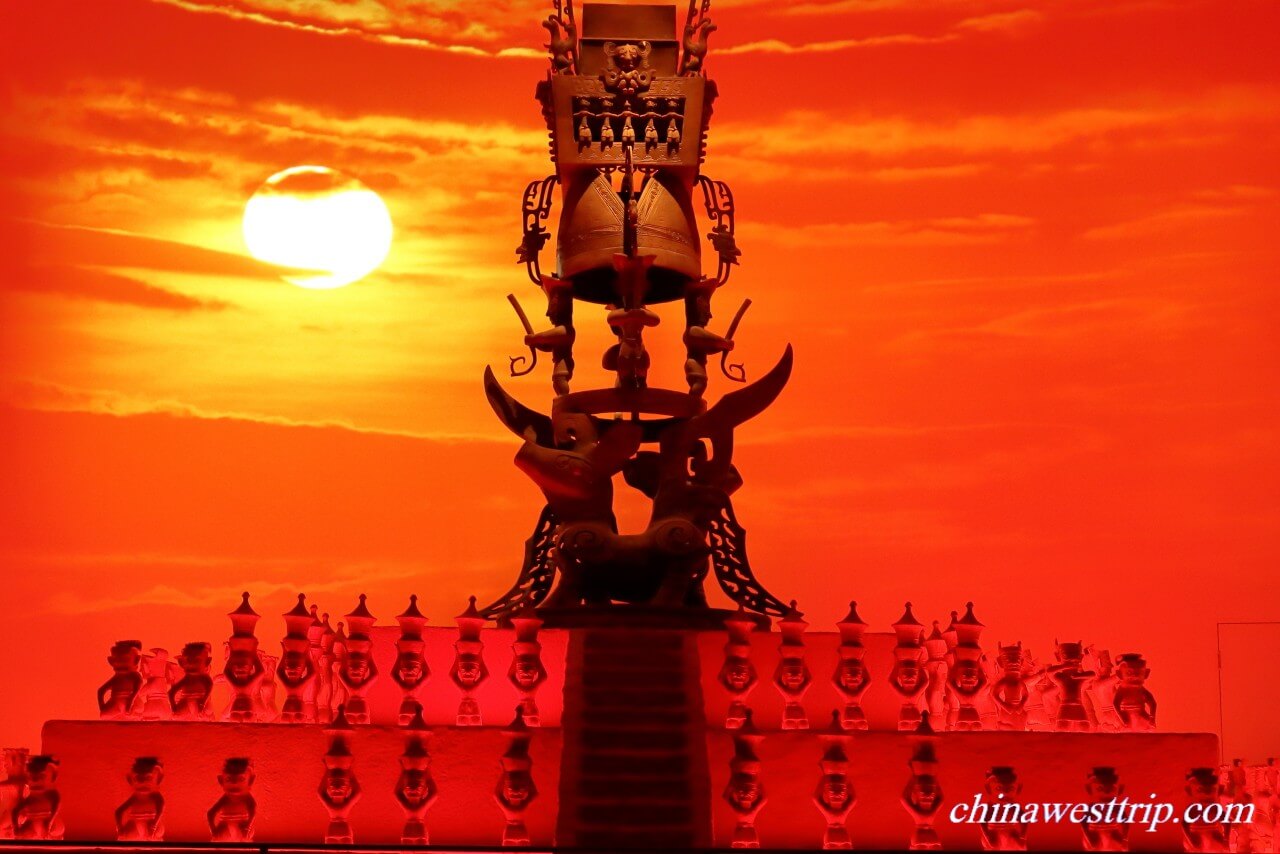
The Altar
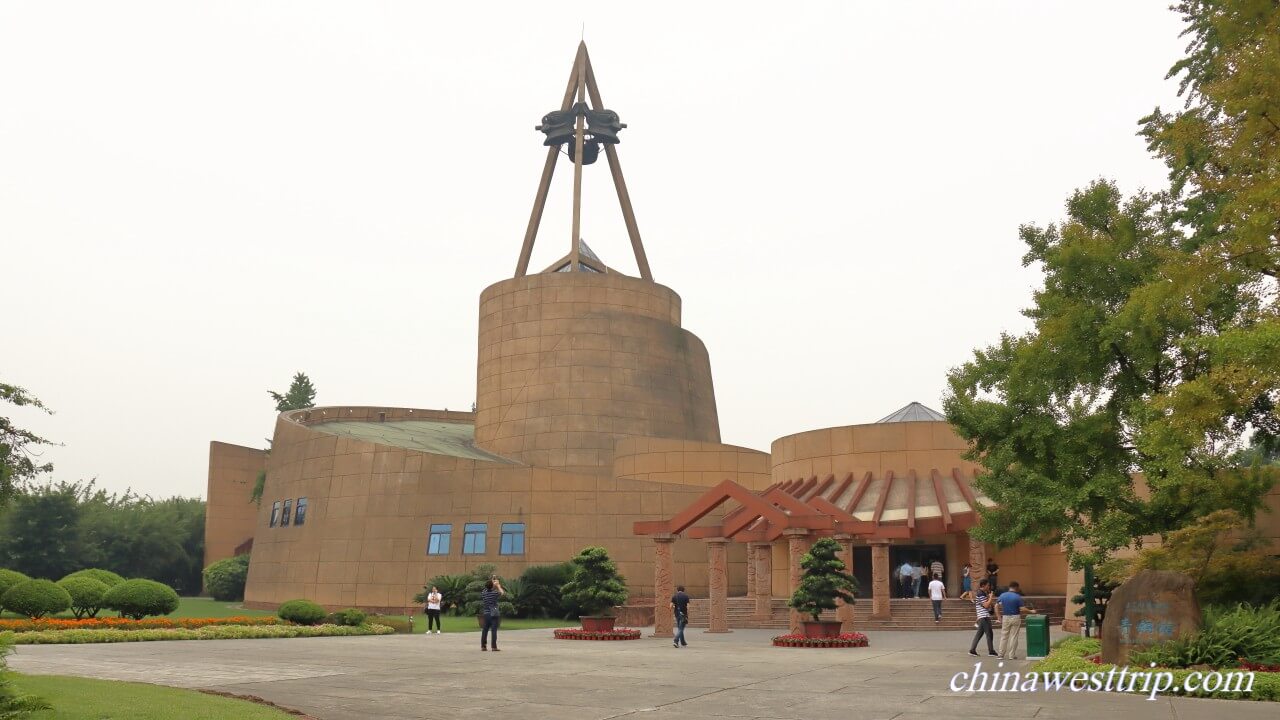
Name in Chinese: 三星堆 Sān Xīng Duī [sæ ʃin dwei]
Duration of Tour: Two Hours
Location: No.133 Xi’an Road, Guanghan City, Sichuan Province
Highlight: Unveiling the Mystery of the Ancient Shu Civilization
Reputations: One of China’s Top-class Museums, A National Four-star Scenic Area, One of Top 20 Attractions for Foreigners Who Travel to China, A State-level Historical and Cultural Relic Site under Protection
Situated in the northwest of Guanghan City, Sanxingdui Site Museum was founded in August 1992, and opened to the public in October 1997. It is 40 km(25 miles) to the north of Chengdu, covering an area of 33 hectares(82 acres). The whole relic site covers an area of 12 square kilometers(2,965 acres). The ruins were discovered by a farmer in 1929, whose name was Yan Daocheng. It happened in spring, when the farmer and his family were digging an irrigation ditch in their fields. His son found a circular piece of jade when he dug the field with his hoe. Later, over 400 valuable relics were unearthed at the same spot, including stone articles and jade wares. The discovery of those valuable jade inspired archaeologists’ interests. In 1933, a team from the West China University arrived at the site and started excavation. The archaeologists realized that the ruins used to be the town of the Ancient Shu Kingdom. Gradually they identified the location of the city walls in the east, west and south, and unearthed the ruins of huge palace with over ten thousand relics. A river called Yazi River flows through the north edge of the excavation site. So far, the archaeologists have not found the city walls in its north part. The archaeologists and historians concluded that the site of Sanxingdui Ruins used to be the capital of the Ancient Shu Kingdom, which could be traced back to 16th century B.C.. The discovery of Sanxingdui Ruins helped greatly to prove that the Yangtze River Civilization and civilizations somewhere else in ancient China coexisted with the Yellow River Civilization, and the Yellow River was not the only birthplace of Chinese Civilization.
In spring, 1934, with a team from the West China University, an American archaeologist, Ge Weihan went to the site for a long-term excavation. Their excavation lasted for ten years. About 400 pieces of jade wares and other articles were unearthed during the excavation.
Between July and September, 1986, archaeologists discovered two large-scale covered holes in the ground, which were named as No.1 Sacrificial Pit and No.2 Sacrificial Pit. More than one thousand pieces of relics were unearthed from the two pits. The archaeologists believed that the two holes used to be the places of worship where the ancient Shu people offered sacrifices to their god or ancestors. The relics unearthed include masks, figures, vessels, scepters, sculptures of animals, ornaments, tools and weapons. Some are gold-wares and jade articles, some others are made of bronze. Each one is invaluable. In 1988, Sanxingdui Site was designated as a National Historical and Cultural Relic Site under Protection by the State Council.
The Main Buildings of Museum
The museum displays the relics unearthed from both the sacrificial pits. It consists of two main buildings, namely the Comprehensive Exhibition Hall and the Bronze-wares Exhibition Hall.
The Comprehensive Exhibition Hall
There are six sections in the Comprehensive Exhibition Hall.
The first section is called “Firmly Occupying the Southwest China Highland”. It displays the history and culture of the Ancient Shu Kingdom which prospered from the late Neolithic Age to the Bronze Age. The Ancient Shu Civilization lasted for almost two thousand years.
The second section is named “Flourishing in the Land of Abundance”. It presents how much the Ancient Shu Kingdom prospered in agriculture and trade.
Named as “Earthenware”, the third section shows the height and feat of pottery the ancient Shu People achieved.
The fourth one is given the name as “Communicating with the Gods by Jade”. It demonstrates the processing technology of jade articles which was utilized by the ancient Shu people three thousand years ago.
The fifth section is named “Smelting by the Raging Fire”. It focuses on how much advanced the metallurgical technology of the Ancient Shu Kingdom was.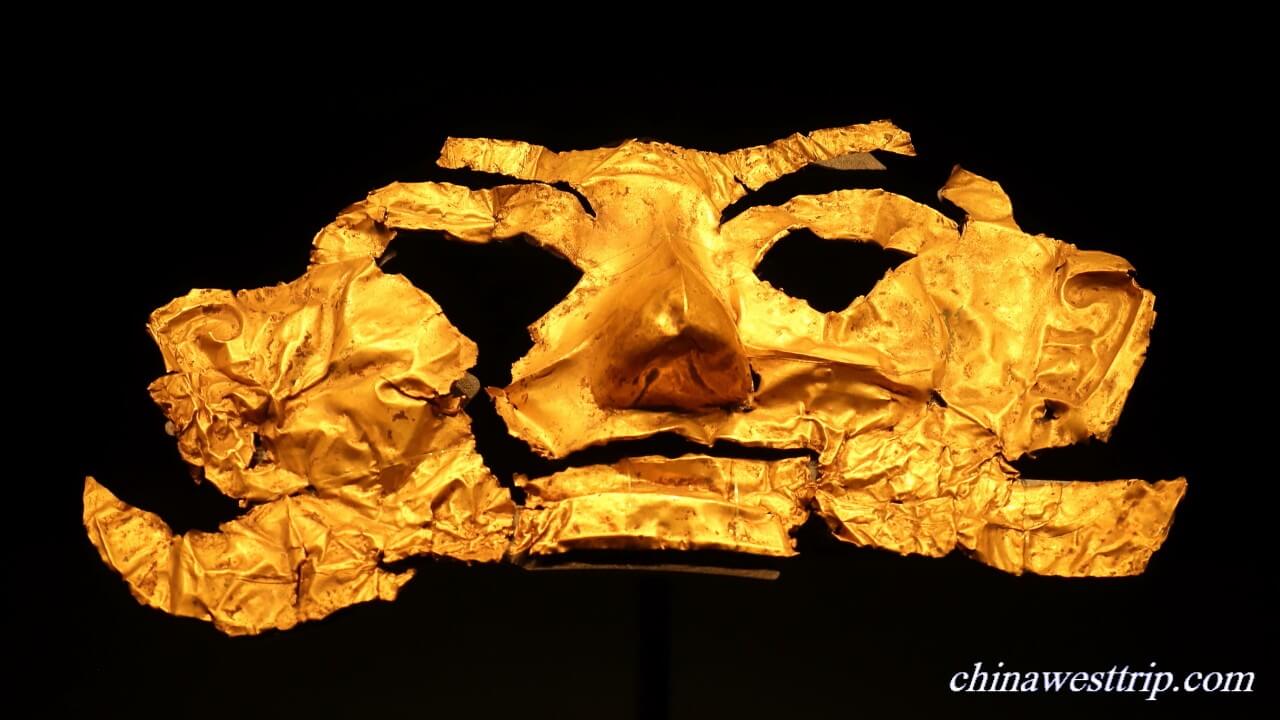
The name of the last one is ”the Holy Bronze Tree”. There are two bronze trees on exhibition. The bigger one is 3.96 meters(13 feet) in height. It was unearthed from No.2 Sacrificial Pit. Archaeologists discovered eight bronze trees from the two sacrificial pits in total. Unfortunately the others appeared smashed and burnt, when those bronze trees were unearthed from the ruins. Only the one on exhibition appears almost perfect after renovation. The whole bronze tree comprises three parts, including the trunk, the pedestal, and the dragon. The trunk is placed on a tripod-like and circular pedestal. Nine branches are cast on the treetop, the middle part and the foot of the tree trunk. Each part of the trunk has three branches. There are nine birds standing in the tree and twenty seven fruits hanging on the tree. A bronze dragon is also cast in the tree. It seems that the dragon is moving downwards the earth. Most of the historians believed that the holy bronze tree depicted what the fairy trees in the legend were like. The fairy trees were called Jianmu and Fusang in Chinese, along which humans could climb to the heaven, and the gods could descend to the earth. The dragon symbolizes the god. It is also commonly believed that the tree used to be the medium utilized by wizards to communicate with the gods. The pedestal is tripod-like and circular in shape, cast with patterns of the sun. The three legs are the symbols of the fairy mountains in the myth, namely Penglai Mountain, Fangzhang Mountain and Yingzhou Mountain. The fairy trees grew on the top of the three mountains. According to the legend, the Heavenly Emperor was the most powerful god. He had ten sons. Each was the incarnation of the sun. They transformed themselves into crows. The ancient Chinese called the sun as the golden crow. There were ten golden crows. Every morning, the sun was carried up to the sky by each of the golden crows in turn. That is reason why there are nine birds cast in the tree. The other one must have been on duty. The Holy Bronze Tree is the biggest bronze ware unearthed in the whole China.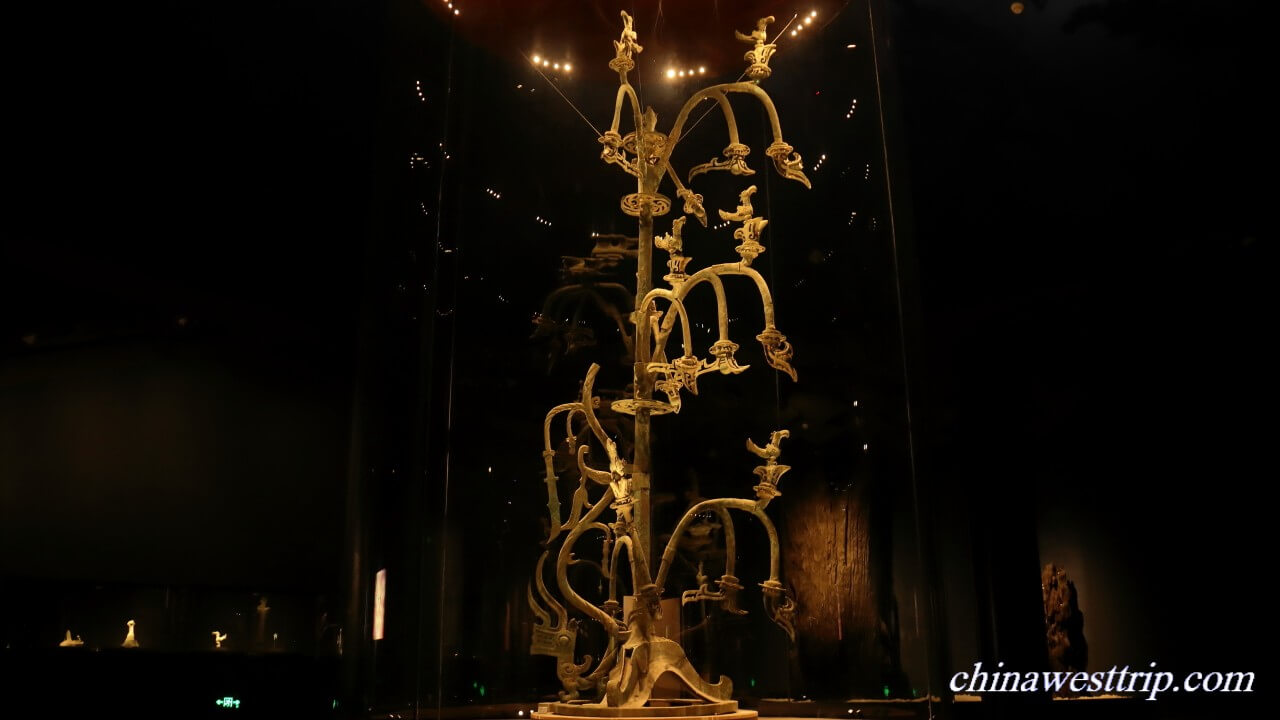
The Bronze-wares Exhibition Hall
The Bronze-wares Exhibition Hall comprises six sections, namely, the Miraculous Bronze Masks Gallery, the Figures of Gods and Wizards, the Sacrificial Altar, the Leader of Wizards, the Gallery of Sacrificial Instruments and the Gallery of Sanxingdui Archaeological Discovery.
The Miraculous Bronze Masks Gallery houses the bronze masks unearthed from both the two sacrificial pits. The most typical one among those exhibits is the Protruding-eyed Bronze Mask. The mask has its own unique design. It has a prominent forehead and a pair of eyes protruding 10 centimeters(4 inches) outwards. The mask looks awe-inspiring as if the figure was a deity descended to the world from the heaven. It is commonly believed that Cancong was the ancestor of the ancient Shu people. According to the historical records, Cancong was the first king of the Ancient Shu Kingdom. The ancient people imagined that their ancestor might have a pair of protruding eyes. It shows that the ancient Shu people longed to explore and understand the world and the universe.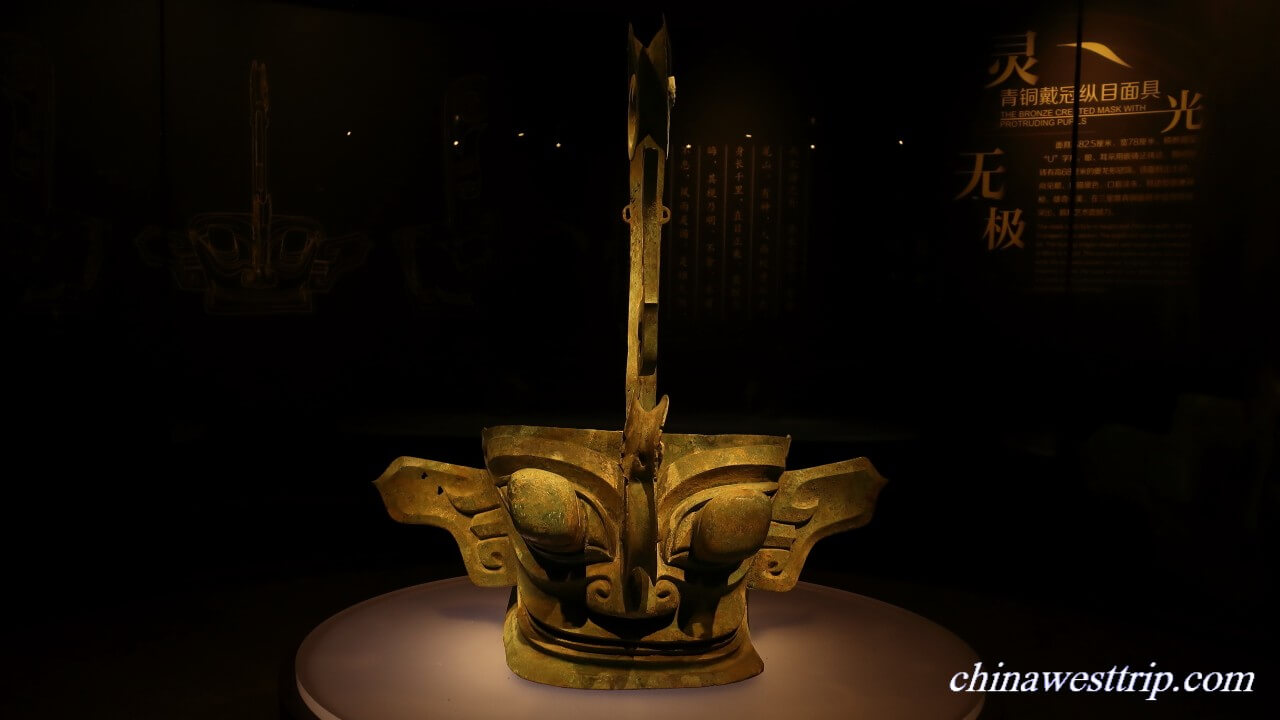
The second gallery is called the Figures of Gods and Wizards. The figures on display are considered to be the symbols of the gods worshiped by the ancient Shu people or the symbols of the rulers in ancient times.
The Altar is a three-tiered terrace. The archaeologists have figured out that the altar is one of the most important sacrificial instruments for a grand ceremony held during a certain period of the Ancient Shu Kingdom. In the Ancient Shu Kingdom, the sacrificial rite was of the prime importance in their state affairs. The altar might have be utilized for the purpose of gaining blessings and good harvest. The altar is related to the knowledge of Heaven, Earth, Deities, and human beings. It reflects the concept of the universe that the ancient Shu people had.
The fourth gallery is named as the Leader of Wizards. The statue displayed consists of the figure and the pedestal. It is 2.608 meters(8.556 feet) in height. The figure has a crown on his head, and is dressed in three clothes. He stands bare-foot and has bracelet on his feet. His hands look as if he was holding something. The archaeologists speculated that the figure might represent either a king or a top wizard. Generally the statue symbolizes the deity, the top ruler of the ancient Shu society.
There are a set of sacrificial instruments on exhibition in the fifth gallery. The exhibits present the level of both technology and ideology which the ancient Shu people achieved.
The Gallery of Archaeological Discovery focuses on the stories happened in the 20th century. It shows how Sanxingdui site was discovered, excavated and protected.
Some of the Exhibits
The Wheel of the Sun
The Wheel of the Sun appeared smashed and burnt when it was discovered. Among the smashed pieces, the archaeologists found six wheels in total. However, they only restored two wheels. The two wheels are in the same size. Both are 85 centimeters(2.8 feet) in diameter. It was the first time in China to unearth the wheels of the sun from ruins. The archaeologists concluded that the worship to the sun was a usual practice dominating the daily life of the ancient Shu people.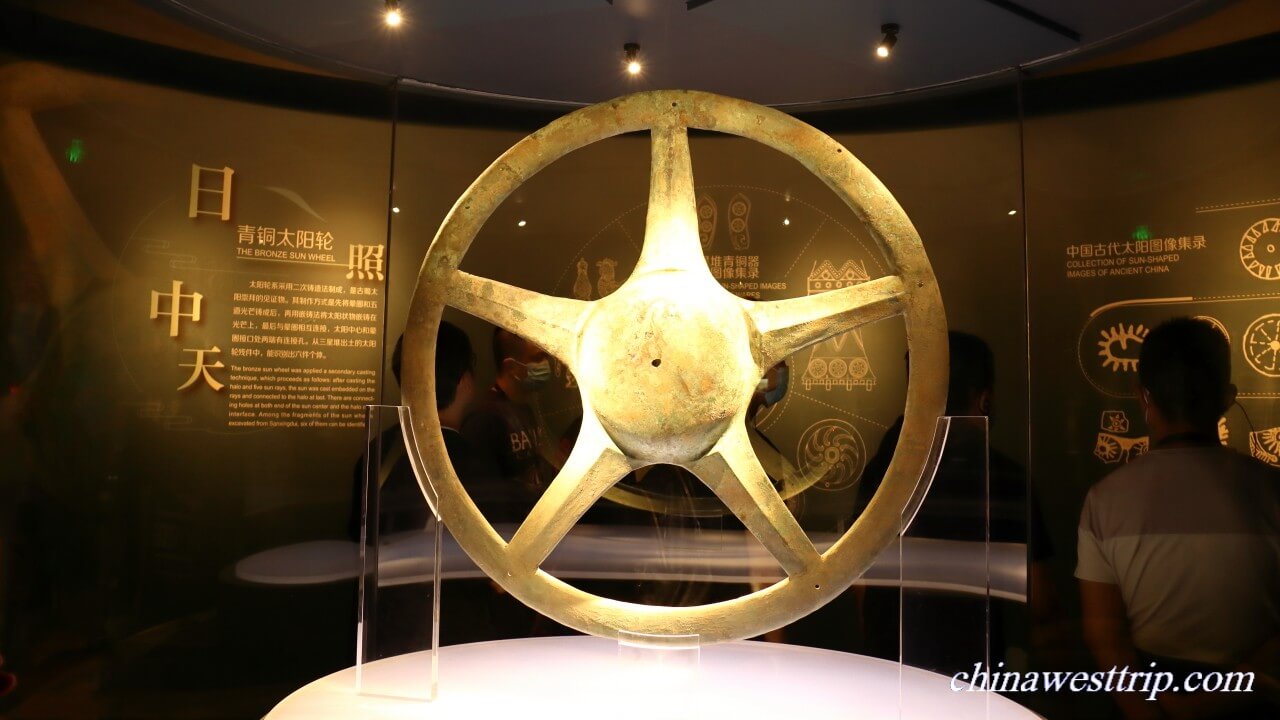
The Bronze Birds
The image of the bronze bird is the symbol of the sun, which indicates the worship to the sun in the Ancient Shu Kingdom. A large number of similar bronze birds were unearthed in Chengdu Plain. The image of the Sun and Immortal Birds Gold Foil which was discovered in Jinsha Ruins suggests that the ancient Shu people practised some forms of totem worship. The sun was carried up to the sky in the morning and pulled down at dusk by four giant birds.
The Big Bronze Bird’s Head
The Big Bronze Bird’s Head is regarded as the king of all the bronze birds excavated from the ruins. It looks like a hawk that remains beak shut and eyes widened. It is 40.3 centimeters(16 inches) in height. The archaeologists have unearthed a great number of bronze-cast birds from the ruins in Chengdu Plain. They concluded that bird was of a very important totem for worshiping in the Ancient Shu Kingdom. Even the legendary kings of the Ancient Shu, Boguan and Yufu are known to be named after birds. The hawk-like bird might be the totem which was used by the ancient Shu people to worship the third king, Yufu. In the local dialect, yufu means fish hawk, and boguan means white crane. According to the records of the Huayang Chronicles, the Ancient Shu Kingdom was established as early as the legendary Pre-xia Kingdom, it co-existed with the Ancient Ba Kingdom. Huayang refers to the vast land covering the south of Hua Mountain, the current southwest China. The Ancient Shu Kingdom occupied the west part of Huayang Land. The Ancient Ba Kingdom dominated the east part, the present Chongqing. The Ancient Shu Kingdom was ruled by three kings one after another, namely, Cancong, Boguan and Yufu. Cancong means silkworm. It is said that he taught his people to raise silkworms and produce silk 4,000 years ago. Historians figured out that the three kings’ names were also used to refer to those civilizations which had prospered one after another in different parts of the land.
The Gold Scepter
The Gold Scepter is 1.42 meters(4.7 feet) in length, 2.3 centimeters(0.9 inch) in diameter, and 500 grams in weight. It was unearthed from the No.1 Sacrificial Pit. The archaeologists found out that there were some carbonized wooden sediments on the Gold Scepter, when it was discovered. They deduced that the craftsmen of the Ancient Shu Kingdom first hammered a gold bar into a thin sheath, and then wrapped a wooden scepter with the gold sheath. Some patterns are inscribed on the Gold Scepter. The patterns are 46 centimeters(18 inches) in total length, consisting of three parts. The first part is carved with two human heads. The two heads look the same, wearing crowns and having earlobes in triangle shape. The other two parts consist of two birds whose heads face each other, and two fish whose tails flank the axis of the scepter. An arrow is flanked by the two birds and the fish. The scepter is a symbol of supreme power.
The Gold-masked Bronze Human Head
The Gold-masked Bronze Human Head has the same features as described in the Protruding-eyed Bronze Mask. The glittering head looks dignified as if he was a deity from the heaven. So far, archaeologists have never found the similar gold masks elsewhere in China. Probably, artisans elsewhere did not grasp the technology sufficiently sophisticated to smelt gold during the Shang Dynasty.
The Zhang Jade Tablet
A large number of jade articles were excavated from Sanxingdui Ruins. The Zhang Jade Tablet is quite unique. It is engraved with patterns. The jade tablet was an offering to worship the god of mountain.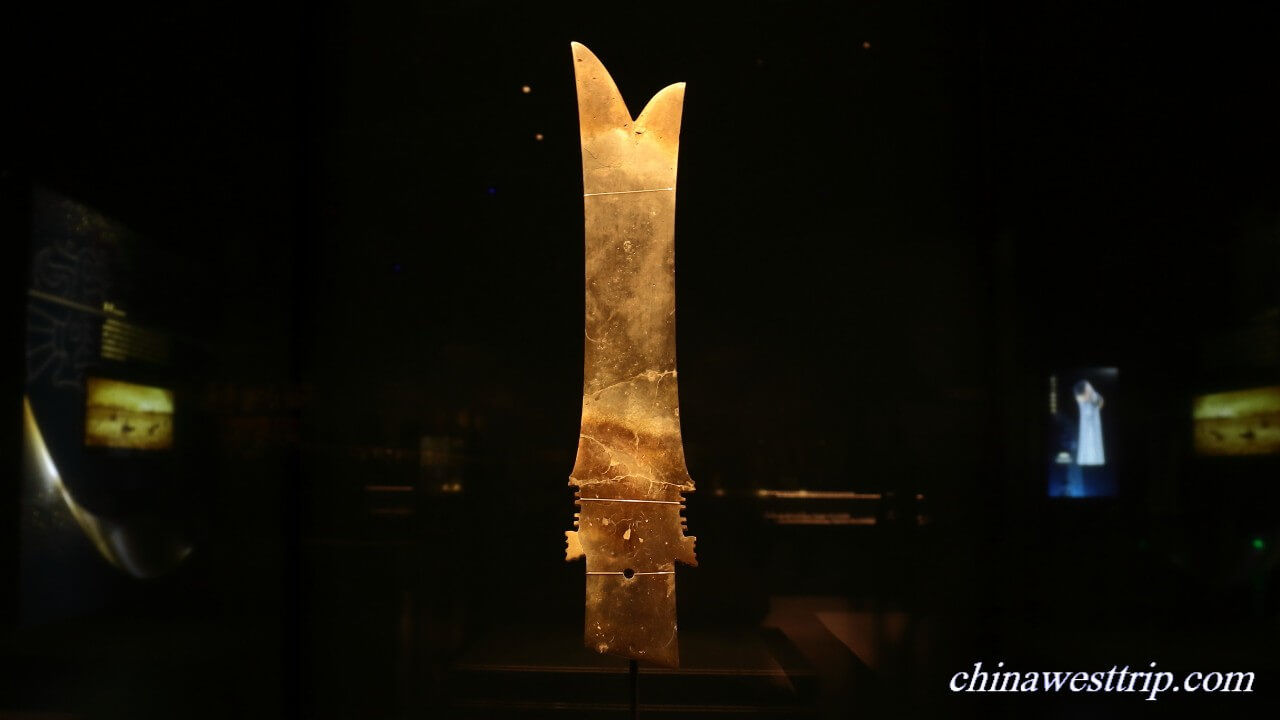
Opening Hours:
8:30 A.M.---6:30 P.M. except for Monday
Related Articles:
The Ancient Shu Civilization
Jinsha Site Museum
Sichuan Provincial Museum
Author: Tina Luo
Update:

The Altar
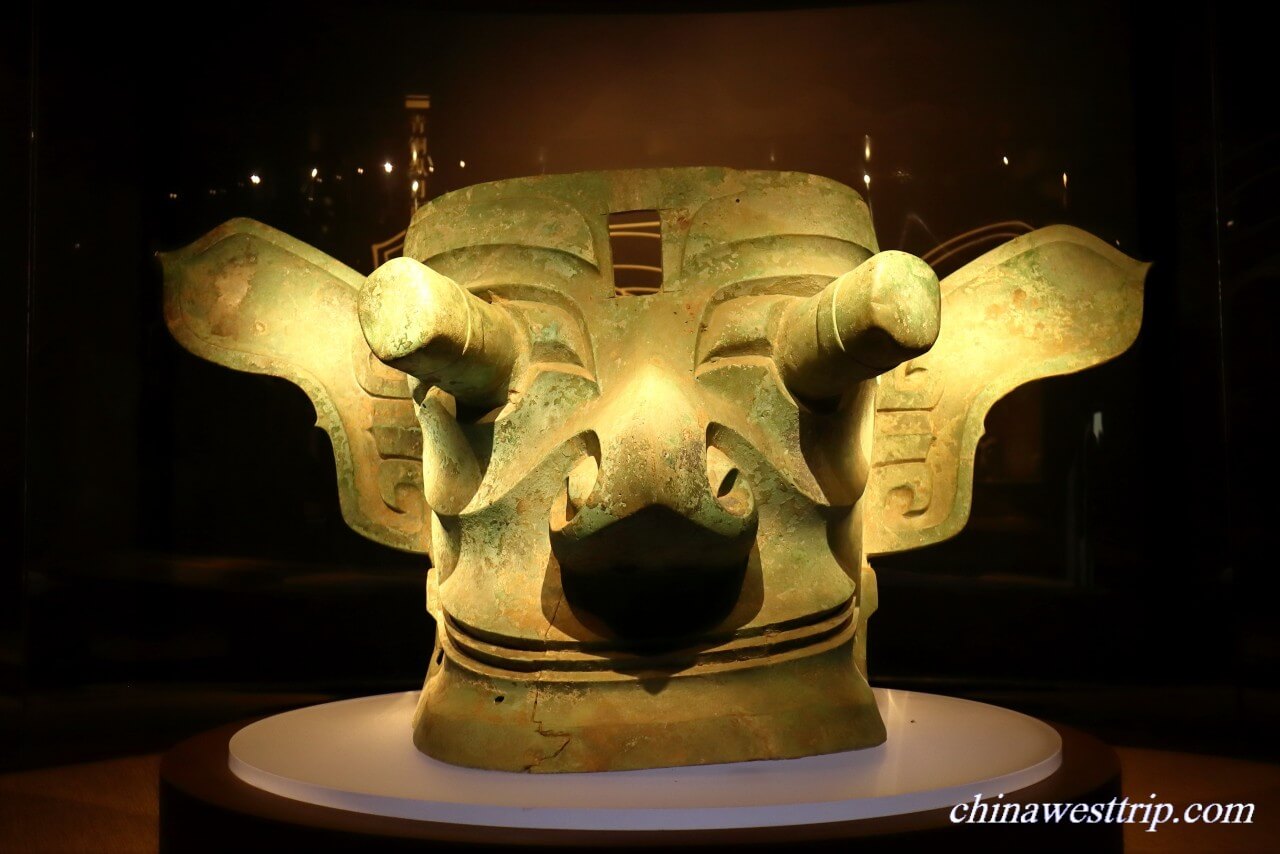
A Bronze Mask
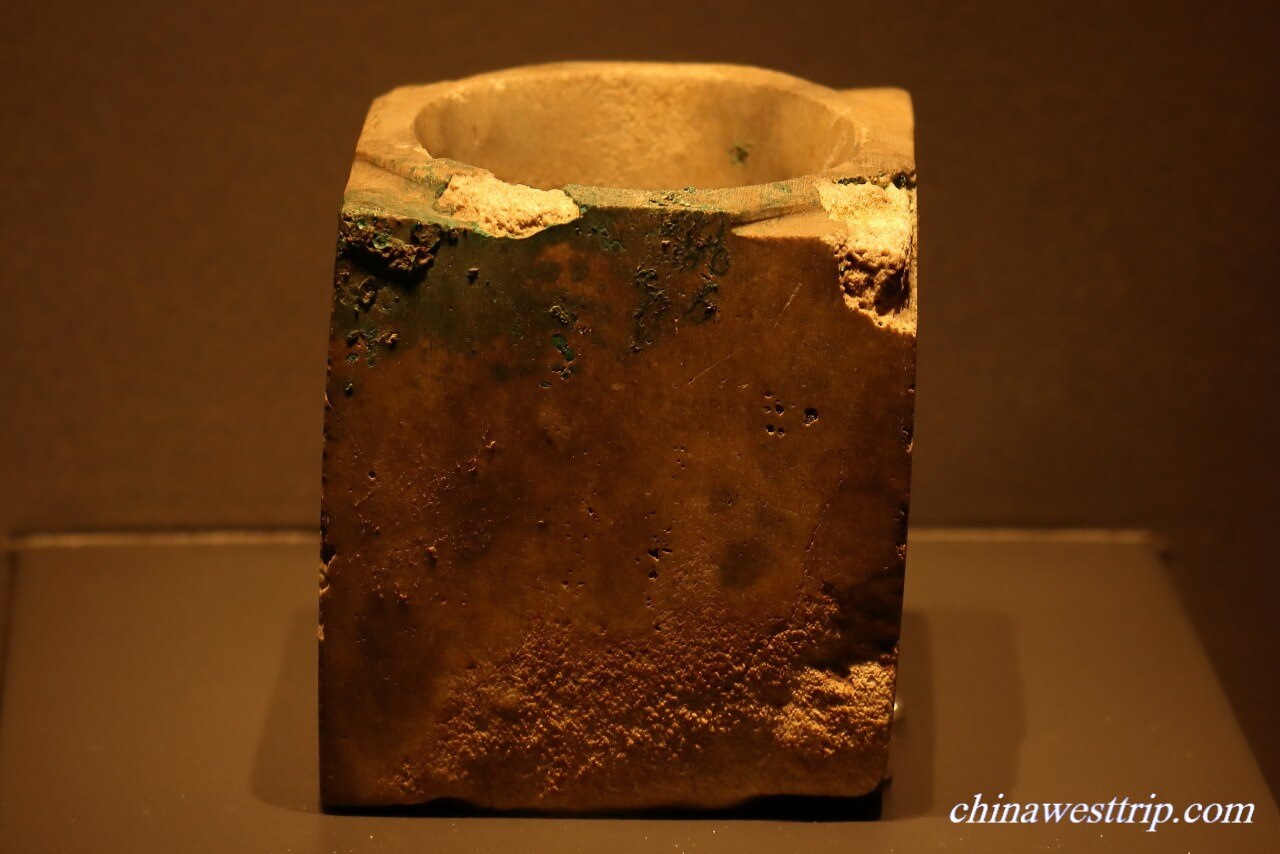
A "Cong" Jade-ware
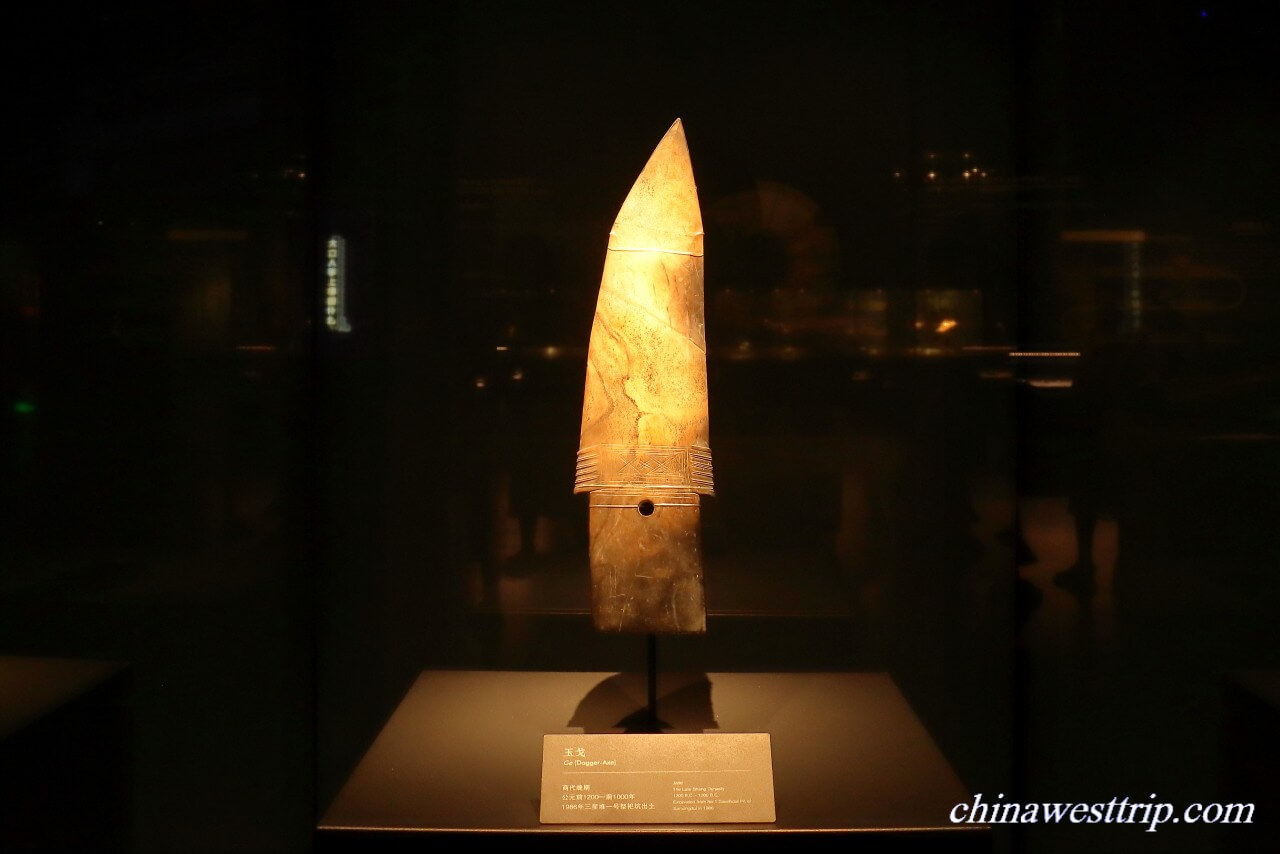
A Jade Dagger
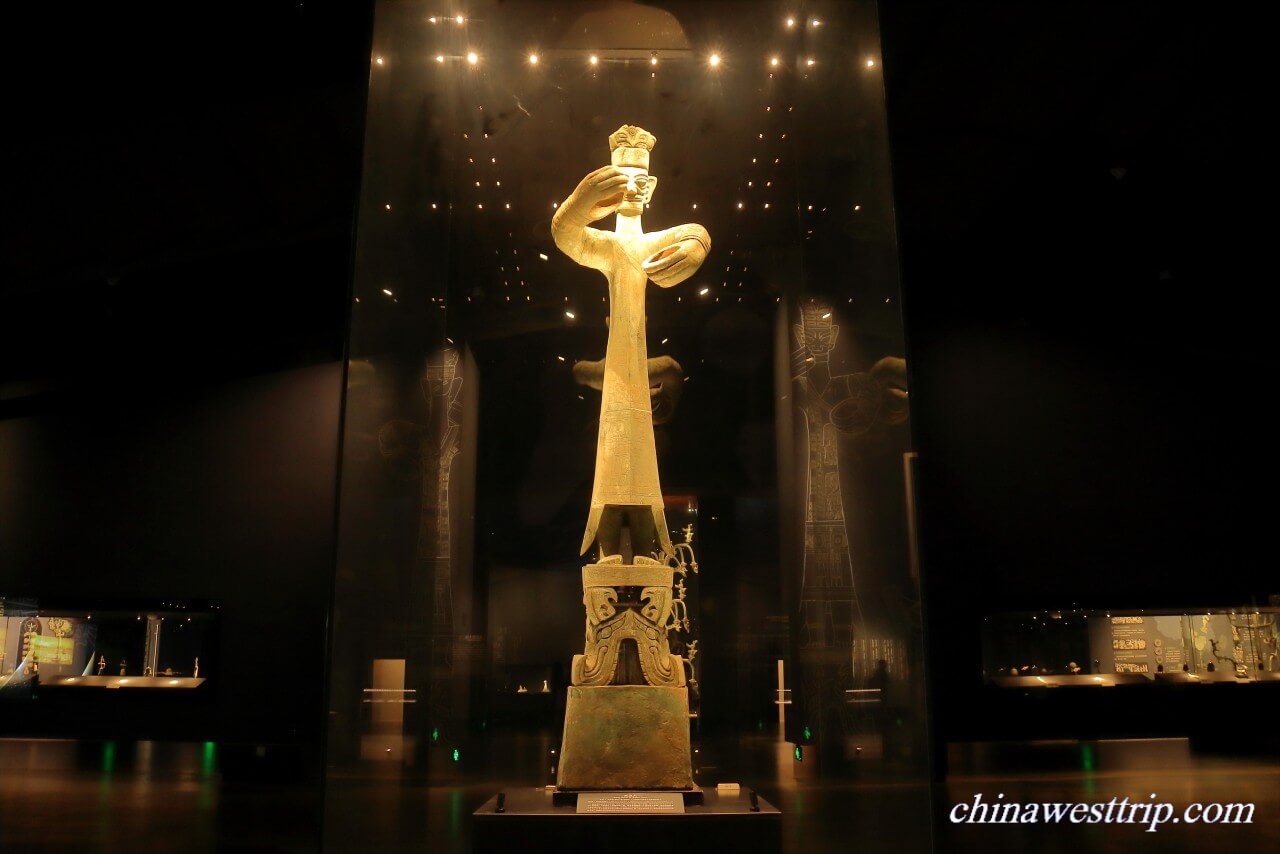
A Bronze Figure of Wizard
A Bronze Ware